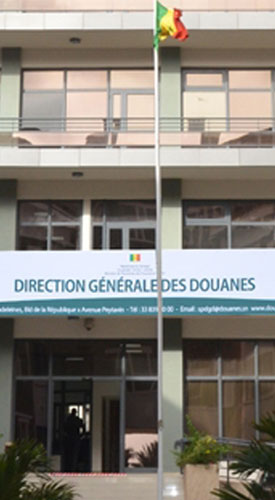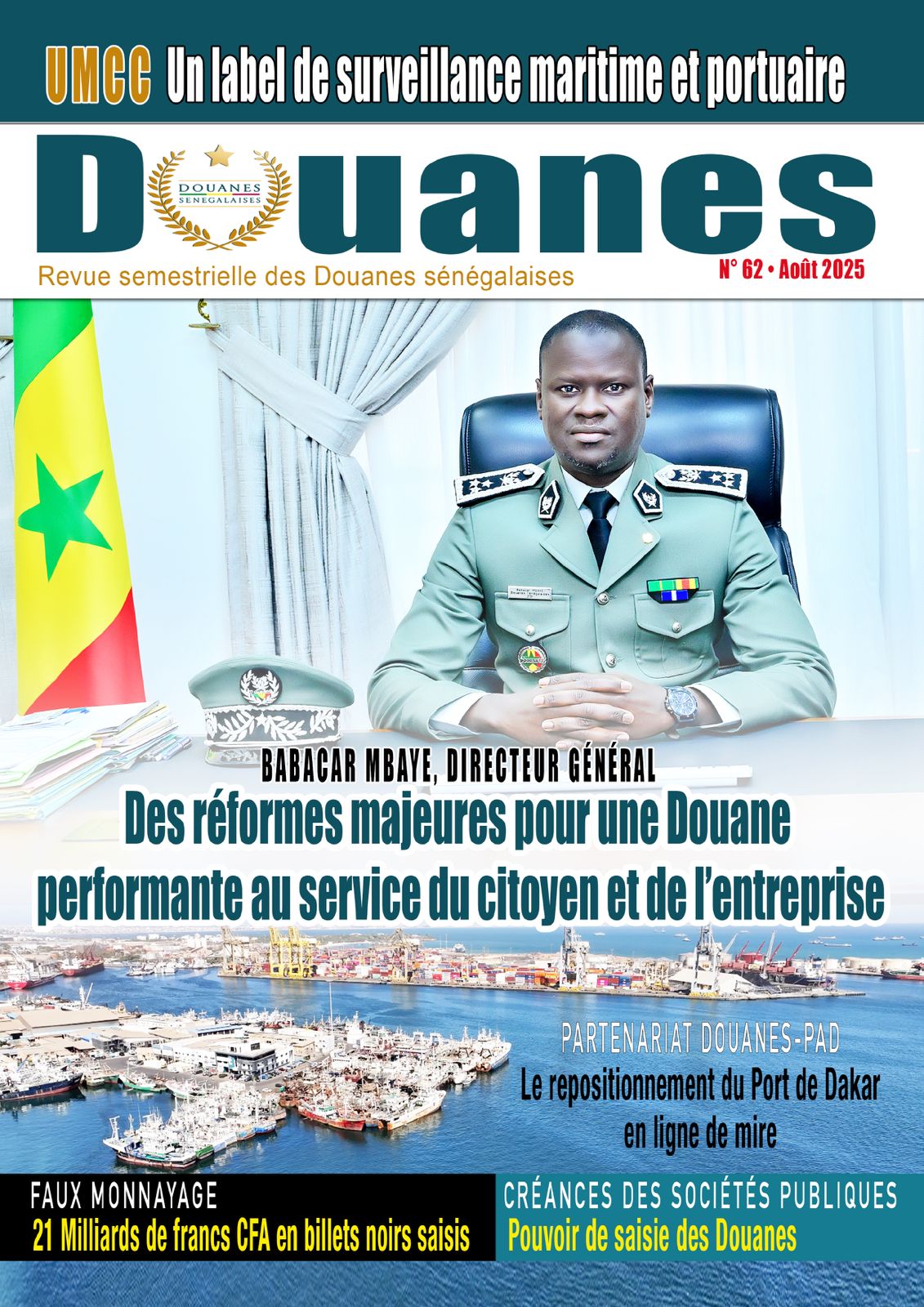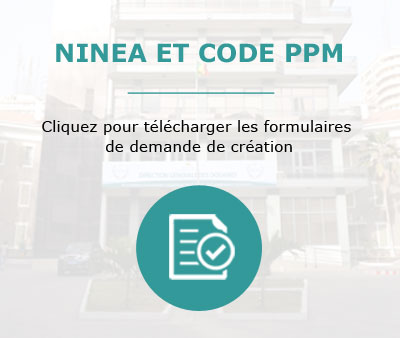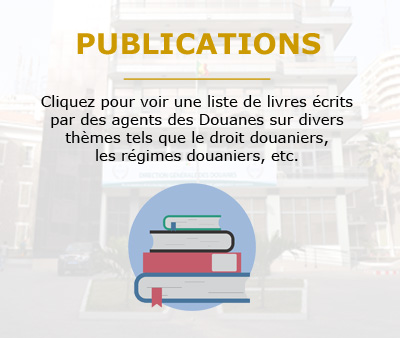Customs’ administration needs a practical and judiciary instrument suitable to the achievement of the different assigned missions… In fact, a constant adaptation of its organizational instrument is vital when trading transactions, a generator of activities, become more and more diverse and sophisticate.
This double requirement justifies the noticeable choice of Senegalese customs to rely on a coherent organization in order to better consider budgetary matters (control services of goods’ operation) and the economic protection (monitoring services).
Known as « customs’ offices », control services of trading operation are mainly entitled to ensure the settlement of duties and taxes applied to diverse regulations related to international exchange.
Their intervention which used to be fiscal precedes that of security units. « Customs’ offices » aim at funding public institutions in order to deal with numerous responsibilities. Nevertheless, next to its first mission comes the economic one, that of protection (monitoring services) through the implementation of a set of measures in order to help and support international trading operation.
Offices are not opened, at the same time, to all customs’ clearances since imported goods and place of access varies throughout customs’ areas. Nevertheless, the greatest part of the trade traffic is designated to the big customs’ offices at the port and airport for the wide scope of activities and the volume of covered operations, are like the fundamental chain of the customs’ action through tax system and economics. These services, as the secular arm of the general management of Senegalese customs in fulfilling its public mission service are worth to be considered. Rethinking their organization and running is crucial since it appears like the main core to adapt them constantly in the context of globalization, source of many constraints. Such an approach will allow appreciating the relevancy of the classic specificity of this administration which depends on the functional bipolarization between writing sections and customs’ inspection+.
Gradually, in this first analysis as a real « way of access » of a great office and , writing sections deserve an interest and basic mainstay of customs’ clearance services for their various involvements to carry out the customs’ strategy or policy. The time of such an interest has come if we consider the dominant prejudices which used to confuse the given appreciation as far as roles are concerned and the main services including the device of a great office.
The purpose of this contribution is far from being the claiming of exhaustiveness but to report in a summary way important attributions remitted to the writing sections. It is remarkable that laws stipulate the organization of the customs’ services and show that these services are built up around three competences. The regulation of customs’ formalities, the control of warehouse management and the monitoring of responsibilities for subscriptions liable for taxes constitute the above-mentioned three main domains.
I/THE REGULAR CONTROL OF CUSTOMS’ PROCEDURES
Resulted from the administrative devolution, the customs’ offices under the overseeing control of central authorities ensure the regulation of goods’ traffic. In so doing, this service makes sure that all actors of international transactions are respecting legal prescriptions when goods get into customers’ area.
The fulfillment of such an important function is based on a large part on writing sections which play a fundamental role in this context, by carrying out diverse panoply of regulation which its purpose is to ensure the conformity to international law on customs’ operations. This mission of control in practice has two directions. On the one hand, we have the one corresponding to the admissible of declarations in details and goods’ mattresses stocked as suspensive regimes on the other.
A.The allowable control agaisnt taxes
Among the first reasons of the creation is these sections have been created consist of writing by checking at the same time de declaration on allowable against taxes. It concerns a control on particularly formal aspect of documents presented for the ends of the outcome. At this time, declarations found not allowable agaisnt taxes are returned to customs’ agents for the regulation.
At first sight this regulation as the mission of the allowable against taxes section is constituted by two forms: an inspection of declaration and a control of including documents. The inspection is related to information customs’ legislation imposes as far as various public regulations are concerned and for its application to the declared goods.
This procedure is meant to check on the presence of important information in order to determine duties and taxes, in addition measures for equivalent effects.
But one must admit that the beginning of automatic declaration resulting from the advent of “GAINDE” (operated management of customs’ information), has largely simplified the allowing against taxes work. Indeed this service of control focuses more and more on the examination of documents which are compulsory. This second stage is crucial because it allows finding out all justificatory documents concerning goods’ situation, from the regulations’ perspective they are submitted.
This importance has been supported by the decree N°91-1221 of November 1991 on establishment of an inspection program on import activities, which, empower writing sections to put up drawing lines leading to the inspection program when there are missing certificated examination concerning goods of “FOB” value is more or equal to three million FCFA and personalized container. Despite that, this kind of control does not cover all writing services which also encompass all an interesting work on suspensive customs’regulations.
B. Inspection of goods under suspensive condition
According to Pr Berr and TREMEAU , economic regimes refer to those “meant to foster the developpement of economic regimes and reinforce companies’ ability to compete with in the international level, through the issue of changeable mechanism in relation to a given activity. Effects of companies able to compete are definitely obtained only when goods to satisfy according to some obligations changeable depending on economic regimes.”
Three systems corresponding to the three basic functions companies have been settled. In this way, commercial regimes which allow either to always get a stock of goods one can use accordingly to one’s needs (bonded warehouse: code regime S3) or importing goods from abroad for a short time and use them in the customs’ area. In this case, duties and taxes are in suspension for needs of a given activity (temporary and particular admission {S51} and particular temporary admission of use {S52};
-customs’regulations on alteration which permit importing goods that would be opened in customs’ area, before being led to consumption, or exporting compensatory products. Normal and temporal admission (S53), particular and temporal admission for active improving (S52) and bonded warehouse (S32) constitute the main forms of customs’regulations.
-Customs’regulations for the support of activities related to goods’trafic which include the ordinary transit (S11) and the international transit (S12). Since these procedures bring into play exceptional techniques in relation to devices on common law of customs’ clearance. This happens basically through the suspension of duties and taxes, the administration must make sure that a set of controls on the normal use of customs’regulations and compel liable which does not apply law to bring them before the courts.
In big offices, sections constitute the master work of the observance device and that of the control suspensive of customs’regulations. Acting suddenly or for a planning suspended by the head of Sections, they proceed to the examination through certificated papers or physical control preceded by preliminaries which function through documentary collects, operated from an electronic listing of mattresses.
At this level, companies’ visits Performed by the AT sections (temporary admission) and bonded warehouse, are very interesting.
Indeed, they allow making sure that goods set in suspensive regimes are not subjected to fraudulent removal. Compensator products already declared for the audition of accounts correspond to regimes that have been set under the considered regime or result from its application.
The action of those services, stemming from a set of laws, often leads to notice that there are many violation of the law. This set of laws is linked to:
– the law 87-47 on 28 December 1987 of the customs’ code,
-the Decree N°7579 MEF/DGD signed on 28 June 1989 determining conditions of application concerning temporary admission regime,
-The Decree n°15238 MEF/DGD on 16 December 1989 dealing with conditions to application related to industrial bonded warehouse
-Decree n°12001 MEF/DGD on 30 September 1989 determining the conditions of agreement and using of the stocking warehouse,
Generally irregulaties are related to:
-the non-control in accordance to the extension granted to mattresses,
-the fact that there is no representation of goods placed under suspensive regime,
-the lack of a portion intended for consumption as far as the consumed part of goods in ATS or the non-respect of obligation to re-export
II/The management of Customs’ warehouse
Since there are some difficulties to grasp the meaning of this concept, referring to the concept of customs’ warehouse, it is useful to enlighten people again before considering modes of goods warehouse.
A.The notion of Customs’warehouse
Customs’ warehouse used to be that, belonging to the administration where goods are temporarily placed before customs’ clearance or retaining for various causes.
Next to this, through a metonymical function, it changes to refer to the judicial situation of goods kept for a moment in a local service. In theory, these goods must be there because of their improper keeping in customs’ post. This second conception of has been formally dedicated by the customs’ law which conceive the “customs’ ware house”, as a transitory, before and after the assignment of a definitive customs’ regime. In the same logic, goods are placed in customs’ posts under the watchful eyes of agents for a precise time. And they should be either alienated or intended to consumption even destinated to re-export.
B. Methods used for goods warehouse
On the basis of clauses of the article 180, the law 87-47 dealing with the customs’ code are constituted first in warehouse:
-imported goods which are not declared in detail accordingly to legal deadline précised in the article 70 stipulated by the customs’ code;
– goods declared in details and which the owner is missing or goods that are not pick up after inspection unless an obstacle comes from a claiming property the staff manager of customs is already informed about.
-goods left in customs’ posts for any other reasons :
In addition to that limited set of clauses accordingly to the article 180 of CD, the customs’ activity has devoted the enlargement of warehouse in two particular situations:
-the case of goods formally prohibited to have an access in the customs’ area and which their import is forbidden;
-the case of goods expected to be cleared through customs and coming from border countries of Senegal , brought under escort or transire in offices in practice.
By the ends of these different procedures, the warehouse section uses a process of operations of warehouse by noting goods on a particular register, précising also their nature, marks and parcels’ number.
If needed, the warehouse section comes to the conveyance of goods in warehouse and prepares either the alienation of goods which are not taken in legal deadline (four month), or the destruction of out-of-dated products or not well preserved.
III/The monitoring of signed engagement
This key action directs at engagements taken by liable for taxes when the procedures to pick it are simplified, received guarantee and documentary tenders.
A.The management of simplified collection of procedures
The customs’ management has begun ambitious projects of reforms including the modernization of procedures to fit with the swiftness of contemporary economy. This reform aims at encouraging, on the one hand, the decrease of the cost of customs’ administrative formalities, and to speed up the carriage of goods to the final user on the other. In practice, this is noticeable through the establishment of simplified procedures which, at, port take the form of Provisional Permit Carriage in the case of imported goods and the Provisional Permit of loading goods in the case of exported goods. This device for regulation allows companies to ease documentary formalities related to operation in international trade. Thus, the profit-making companies have the chance to give their goods by proceeding to a simplified declaration they submitted to the competent customs’ office. This declaration only claims a limited amount of information related to destination, the name of the boat, the value, taxes category, number of parcels, obligatory duties.
Like any other customs’ declaration, the simplified one can be even deposed before the coming of goods. Of course, all complementary information must be transmitted later to the customs’ services by the means of a declaration based on common customs’ law. The coming of writing sections is before instruction and registration of application through the monitoring of regulation of those simplified procedures. At this level, a particular importance is given to the respect of the time limit concerning regulation (fifteen days), and the content of the declaration which must allow customs’ services to control operations from the regulation viewpoint.
B. The monitoring of tenders and bail receipts
Tenders are the bail agreement taken by owners who give the missing documents in a limit time the service fixes. In fact, it is an ability left to the commissioner when there is a missing of a required document to abstract during the achievement of customs’ formalities. This concern some necessary papers to the exchange of an agreement to that should be given in a relative short time. The writing services must monitor such written agreements written by considering the regulation.
In accordance with the article 112 of customs’ code, transported goods placed under suspensive regime of duties and taxes must be covered by a bail- receipt. The bail-receipt refers to a declaration of goods related to a suspensive customs’ regime, including the agreement to satisfy legal prescriptions related to the using of that regime. Otherwise there will be an equal judicial response with the bail-receipt with non regularities noticed by the service.
In the writings sections the monitoring of receipt-bail is mainly materialized by to check out receipt-bail of the returning of receipt-bail in order control regularities of transit operations or re-export accordingly to obligations related to these regimes(respect of prescribed itineraries, the unload of offices’ carrying, the visa of office’s coming out, etc.)
Consequently, the presence framing of writing services in a bigger office is a solution to double matters. On the one hand, to be able to achieve basic missions of control institutionalized for the preservation the State’s interest by not prejudicing legitimate trading in the eyes of many constraint one encounters. On the other hand, it is a way to offer an opportunity to international trade, concerning administrative formalities and support.
This ambivalent action lies directly within the framework of the World Customs Organization new concerns. This is especially related to the SAFE norms which prescribe the conciliation of control imperatives and facilitation in order to secure the international logistic line. In the big office, the writing sections ensure such a dynamic, a mission beyond determinant. Nevertheless, their contribution is decisive if only there is a harmonious articulation between services.
At the same time, it is clear that how perfect it may be, their structure always stays as a theoretical framework. Thus in practice, employees always determine its value and image.












